General Examination: Sideroom Investigations
The Sideroom Investigations are used to indicate information such as Glucose levels, Urate Tests, LDL and HDL levels, Triglycerides, Total Cholesterol, and whether the patient is Pregnant, has HIV, or Malaria.
- This user manual will start on the General Examination form, Physical Examination panel.

- For more information on how to access the General Examination form, please refer to the user manual: General Examination Overview.
- Click on the Physical Examination panel.

- The Physical Examination panel will expand.

- Navigate to the Sideroom Investigations section.
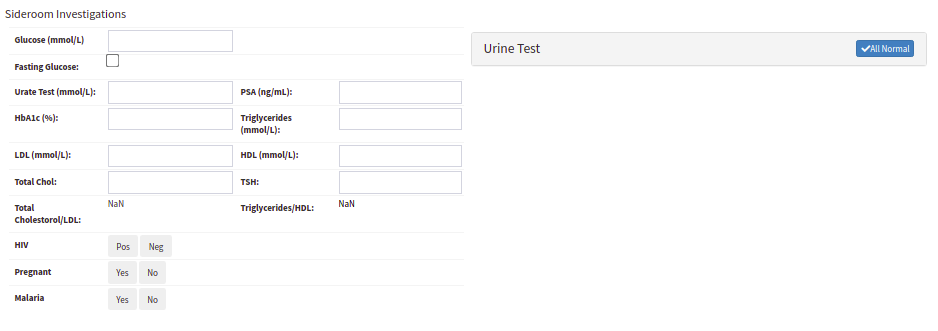
- The following information can be completed under Sideroom Investigations:
![]()
- Glucose (mmol/L): The concentration of sugar found in the Patient's bloodstream, measured in millimoles per litre.

Please Note: The system will warn the user if the blood sugar levels of the Patient are too high or too low, by changing the field red.

- Fasting Glucose: Fasting blood sugar level is tested by drawing the blood of a Patient with an empty stomach after an overnight fast. A reading of fewer than 100 mg/dL (5.6 mmol/L) is considered a normal reading, whereas a Patient with a level higher than 126 mg/dL (7 mmol/L) on two separate tests is considered to have Diabetes.
- Tick the Fasting Glucose checkbox if the Patient completed an overnight fast.
![]()
- Urate Test (mmol/L): The amount of Uric Acid found within the Patient's bloodstream, measured in millimoles per litre. The amount of uric acid in a Patient's blood is determined by a uric acid blood test, often known as a serum uric acid measurement. The test will reveal how well the Patients body creates and eliminates uric acid. Uric acid is a chemical that is formed when a Patients body breaks down foods that contain purines, which are organic substances.
![]()
- HbA1c (%): The haemoglobin A1c test determines the average percentage of blood sugar level of the Patient, over the previous two to three months.
- Normal: Below 42 mmol/mol - Below 6.0%.
- Prediabetic: 42 to 47 mmol/mol - 6.0% to 6.4%.
- Diabetic: 48 mmol/mol or over - 6.5% or over.
Please Note: Abnormal HbA1c levels will be highlighted in red.
![]()
- LDL (mmol/L): The Low-Density Lipoprotein is the amount of bad cholesterol found within the Patient's blood, measured in millimoles per litre. Cholesterol is a type of fat found within the human body, and can be harmful to the Patient when high amounts of LDL are detected.
Please Note: Abnormal LDL (mmol/L) levels will be highlighted in red.
![]()
- HDL (mmol/L): The High-Density Lipoprotein is the amount of good cholesterol found within the Patient's blood, measured in millimoles per litre. Cholesterol is a type of fat found within the human body, and can be beneficial to the Patient when high amounts of HDL are detected.
![]()
- Total Chol: The Total Cholesterol of a Patient is measured by the total amount of cholesterol in the blood, which includes both Low-Density and High-Density Lipoprotein cholesterol.

- Total Cholesterol/LDL: The Total Chol level, divided by the LDL level. The Total Cholesterol/LDL level is automatically calculated by the system.

- PSA (ng/mL): The Prostate-Specific Antigen protein levels in the blood are tested to detect signs of Prostate Cancer. A result with high PSA levels could indicate either Cancer or an infection, and additional screenings are required to rule out the various possibilities.
![]()
- Triglycerides (mmol/L): Triglycerides are a type of fat that gets stored in the body for future energy use, measured in millimoles per litre. Triglycerides levels in the blood should be fewer than 150 mg per deciliter (mg/dL) in order to be considered normal. Between 150 and 200 mg/dL are considered borderline. Triglyceride levels above 200 mg/dl are linked to an increased risk of atherosclerosis and, as a result, coronary heart disease and stroke.
Please Note: Abnormal Triglycerides (mmol/L) levels will be highlighted in red.
![]()
- TSH: A thyroid-stimulating hormone test is used to see if the Patient's thyroid gland is functioning properly. The Practitioner is informed whether the Patient's thyroid is overactive (Hyperthyroidism) or underactive (Hypothyroidism).

- Triglycerides/HDL: The Triglycerides (mmol/L) level divided by the HDL (mmol/L) level is the way the Total Triglycerides/HDL level will be automatically calculated by the system.
- Click on the Pos button to indicate if the Patient is HIV Positive or
- Click on the Neg button to indicate that the Patient is HIV Negative.
![]()
- Pregnant: The Patient's Pregnancy status will be indicated at the Pregnant option. Pregnancy is the term used to describe when a fetus develops inside a woman's uterus.
- Click on the Yes button to indicate if the Patient is Pregnant.
![]()
- Click on the No button to indicate that the Patient is not Pregnant.
![]()
- Malaria: Malaria is a parasite carried by mosquitos. Malaria can be fatal if not taken care of in time, however can be successfully treated on early detection. Flu-like symptoms are an indication of whether the Patient might have malaria, however additional tests are required to rule out other various possibilities.
- Click on the Yes button to indicate if the Patient is Positive for Malaria or
![]()
- Click on the No button to indicate that the Patient is Negative for Malaria.
![]()
Urine Test
- Urine Test: Urine tests are a helpful tool for Practitioners to determine whether a Patient has either Diabetes, a Urinary Tract Infection or various other diseases/illnesses.
- Click on the Urine Test panel to expand.

- Click on the All Normal button if all the results are Normal.

- The Urine Test panel will turn green to indicate that the results are All Normal.

- An explanation will be given for each Urine Test drop-down menu:
![]()
- SG: An SG test is referred to as a urine specific test, and is a comparison of the density of the Patient's urine, to water. The results of an SG test can determine whether the Patient's kidneys are functioning as they should.
- Click on the SG drop-down menu to open a list of results that the Practitioner can choose from.
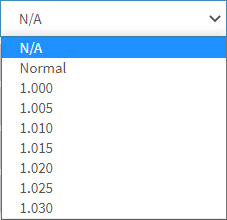
- Select the relevant result from the list.
![]()
- pH: The pH of urine is a measure of how acidic or basic the Patient's urine is. By testing the acidity of the urine, a Practitioner can diagnose various diseases from infections to Kidney Stones.
- Click on the pH drop-down menu to open a list of results that the Practitioner can choose from.
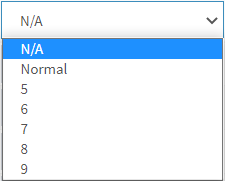
- Select the relevant results from the list.
![]()
- LEU: The Leukocyte Esterase test is done to find any white blood cells in the urine, which is a general indication of a present infection.
- Click the LEU drop-down menu to open a list of results that the Practitioner can choose from.
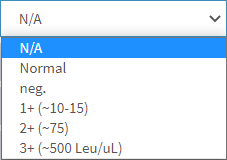
- Select the relevant result from the list.
![]()
- NIT: The presence of bacteria in the urine causes Nitrates to be turned into Nitrites.
- Click on the NIT drop-down menu to open a list of results that the Practitioner can choose from.
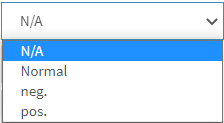
- Select the relevant result from the list.
![]()
- PRO: The amount of protein found in the urine is an indication of kidney function. High levels of protein could be the cause of improperly functioning kidneys.
- Click on the PRO drop-down menu to open a list of results that the Practitioner can choose from.
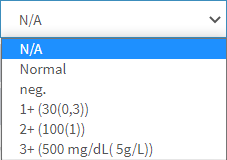
- Select the relevant result from the list.
![]()
- GLU: The glucose levels in the urine is a simple way to determine whether the Patient potentially shows signs of Diabetes.
- Click on the GLU drop-down menu to open a list of results that the Practitioner can choose from.
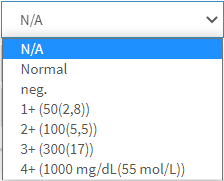
- Select the relevant result from the list.
![]()
- KET: High Ketone levels in the urine could be an indication of serious health issues related to the Patient's sugar levels, and is often found in Patients with Type 1 Diabetes.
- Click on the KET drop-down menu to open a list of results that the Practitioner can choose from.
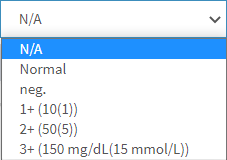
- Select the relevant result from the list.
![]()
- UBG: The presence of an abnormally high or low amount of Urobillinogen is an indication that the liver is not functioning properly, and could possibly be diseased with Hepatitis or Cirrhosis.
- Click on the UBG drop-down menu to open a list of results that the Practitioner can choose from.

- Select the relevant result from the list.
![]()
- BIL: A bilirubin test detects the amount of a specific yellow/orange pigment produced by the liver, which is found within the urine.
- Click on the BIL drop-down menu to open a list of results that the Practitioner can choose from.
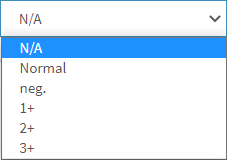
- Select the relevant result from the list.
![]()
- ERY: An Erythrocyte test detects any presence of red blood cells in the urine, which is a general indication of a present infection.
- Click on the ERY drop-down panel to open a list of results that the Practitioner can choose from.
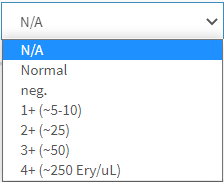
- Select the relevant result from the list.
- Click on the Close button to exit the Clinical screen without saving.
- Click on the drop-up menu next to Save and Close for more saving options.

- Save: The user is able to save the changes made to the form without closing the form.
- Save Lines To New Macro: Allows the user to create a new macro.
- For an extensive explanation of the New Macro feature, please refer to the user manual: Macros (Billing Combinations).
- Click on the Save and Close button to save the General Examination form and close the screen to return to the Diary screen.
![]()
Last modified: Monday, 24 November 2025, 10:48 AM